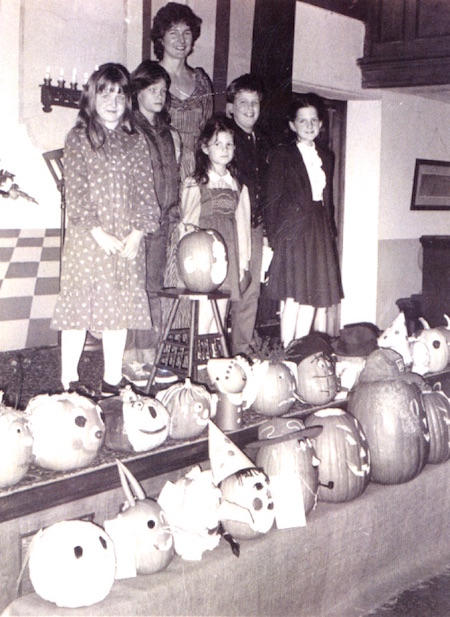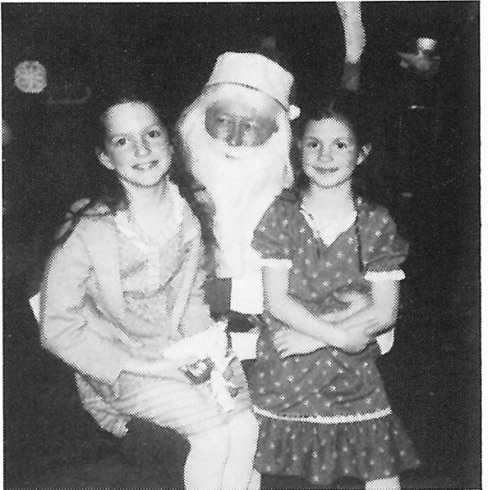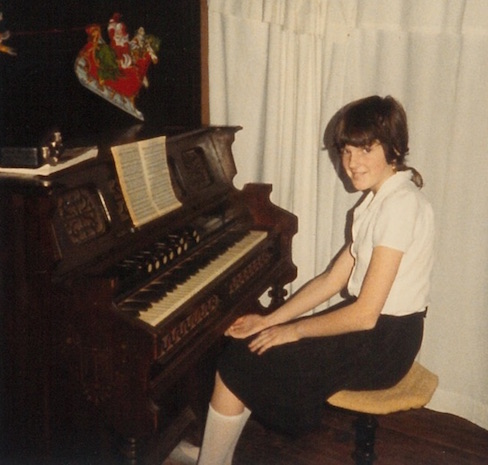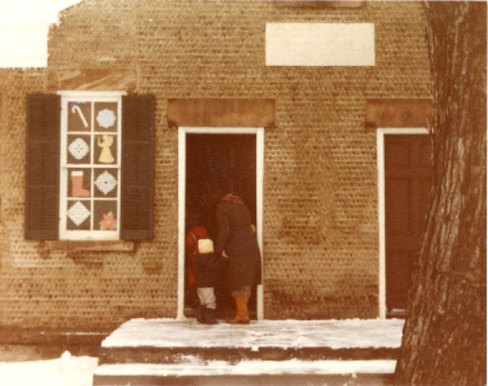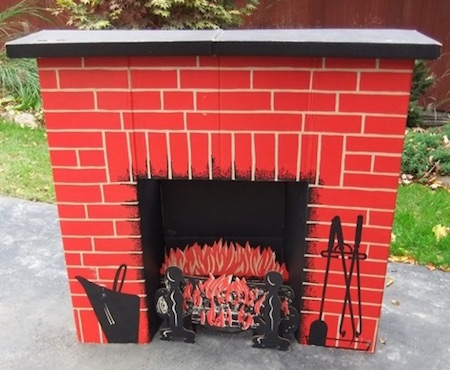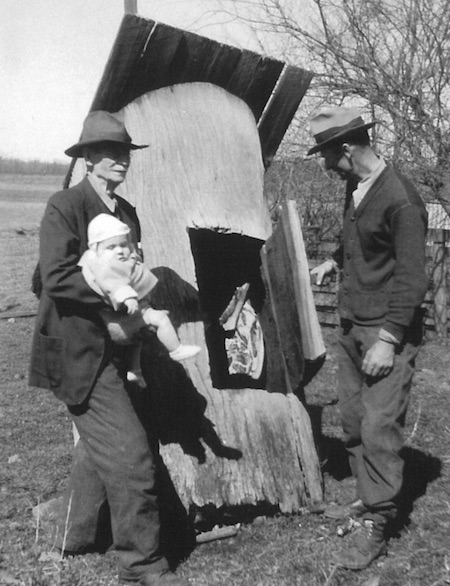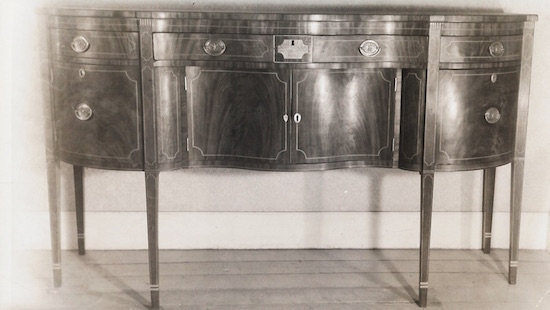Historic Childs: The Lattin family, three generations of local historians – Part 2
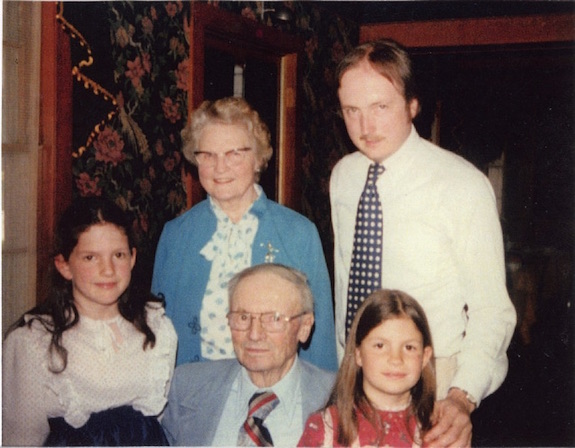
Adrienne Kirby selected this family photo as one of her favorites. It was taken in 1983, most likely at the Village Inn for the celebration of her grandfather’s 85th birthday. Adrienne is seen at left, next to her grandfather, Cary Lattin and her younger sister, Allison Lattin. Standing in back is her grandmother, Avis Lattin and her father, Bill Lattin.
By Doug Farley, Cobblestone Museum Director
(Author’s note: It became obvious to me while working on what turned out to be Part 1 of the History of the Lattin family in the Hamlet of Childs and environs, that one article alone would not do the story justice. So, without further ado, here is the second installment. (If you missed article 1, you may want to back up a week and check it out or click here.)
Adrienne (Lattin) Kirby, current Town of Gaines Historian, is happy to explain how she is the third rung in the ladder of historic preservation, so to speak, as both her father, C.W. (Bill) Lattin, and grandfather, Cary Lattin, have greased the wheel by providing her so much interesting historical information over her 46 year lifetime.
The Lattin family and the Cobblestone Museum, have in many ways become synonymous over the years with community engagement. Whether it was hosting school tours for up to fifty classrooms each year, or inviting the community to take part in the Pumpkin Festival, with prizes given to historic themed entries.
Adrienne remembers this particular Festival in 1982 because of the pumpkin sitting on the stand next to her. She recognized the “O.C.” which stood for Orleans County, and a carved cello which was the instrument that Pamela Frame played for this program in the Cobblestone Church. The children taking part in this photo include (Left to Right): Marsha Bolton (now Rivers), DeeDee States (now DiMarco), Allison Lattin, Richard Bowen, and Adrienne Lattin (now Kirby). The adult in the center of the photo is Pamela Frame, the cellist who played for the event.
Another fond remembrance for Adrienne was the annual Christmas pageant at the Schoolhouse. “Janice (Thaine) did those for many years, and I remember them fondly. I was in a skit called ‘The Christmas Belles’ about 3 sisters, whose names were Laurabelle, Clarabelle, and Isabelle.” Adrienne (left) and sister, Allison, are seen here in 1982 with Santa (Gerald Thaine) at the Schoolhouse.
Janice Thaine offered up the Christmas pagents in the 1970s and 1980s. Here we see Adrienne and Allison Lattin at the right side of the first row of children.
A makeshift “theater” was created each Christmas at the schoolhouse, by stringing a collection of sheets across the front of the classroom for a makeshift stage curtain, as seen here. The audience sat in the student’s desks. Adrienne said, “I’m sure I played the organ for the program in 1985 (pictured here), I would have been taking lessons with Miss DiGuilio. She was in Albion, but a lot of people around here will remember her.”
Young actor, Danny Capurso, age 4, with his mother, Chris Capurso, are seen arriving at the schoolhouse in 1983. Some of Janice Thaine’s handmade Christmas decorations are displayed in the window. The program was composed of children reciting seasonal poems, short skits and music.
Adrienne said, “Every year, we sang ‘Up on the Housetop.’ I seem to remember having to snap my fingers at the ‘click, click, click,’ and a few other hand gestures. The show always closed with Janice sitting in the teacher’s chair, reading ‘Twas the Night Before Christmas,’ with all the kids sitting on the floor around her. Her husband Gerald, would dress up as Santa Claus and kids would take turns sitting on his lap. I think the wire for the curtain is still there. The curtain was just some white sheets pinned together.”
Adrienne reminisced, “ I distinctly remember when I was in 1st grade wearing lace up shoes with rather thick, soft rubber soles, because that was fashionable in 1980. I stood on the metal grating above the furnace long enough for it to melt an imprint into the bottom of my shoe. I remember Janice also brought in a cardboard fireplace, most likely from the 1950s, as sort of a backdrop.”
Folks who have toured the Farmers Hall at the Cobblestone Museum probably remember the large smokehouse and bin there were created from sycamore limbs. What they may not know is the artifacts’ connection to the Lattin family. Sometime in 1870s, Adrienne’s great-great grandfather, Bartlett decided to cut a huge sycamore tree in Kuck’s Woods. He was assisted by a friend, and the two men decided to each take half of the wood.
The sycamore tree they selected was 90 feet tall, six feet in diameter, and about 20’ in circumference. One of the characteristics of sycamore trees is they usually become hollow on their own. Bartlett used half of the trunk to create a log bin, seen here occupied by Cary Lattin in 1902, and Barlett’s friend used the other half of the trunk for a chicken coop.
Bartlett also used one limb measuring three foot in diameter for a smokehouse. The sycamore smokehouse is shown here in 1945, with Cary Lattin at right. Cary’s father, Nahum, is holding his grandson, Bill Lattin. The family trio is inspecting meat hanging inside the smokehouse. In 1980, Cary gave the sycamore smokehouse to the Cobblestone Museum to preserve.
It’s no secret that the Lattin’s have enjoyed collecting antiques. Bill has even “set up shop” at regional antique stores. One of the items that Cary and Bill were fond of is displayed in their homestead and has a six generation connection to the Lattin family. Adrienne’s great- great-great-great grandfather, Nathaniel Lattin, purchased a Hepplewhite sideboard in a shop in New York City in the 1830s. It was second hand at that point, and the family tells the story that it was once owned by a sea captain and was used in his cabin on a sailing vessel. Nathaniel recognized it as quality furniture.
When Nathaniel died, he passed it on through the “greats,” first to Joseph, then to Joseph’s son, William. The story is told that Bartlett Lattin, William’s brother, liked the piece of furniture so much that he offered a milk cow in exchange, if his brother William would give him the sideboard. Succeeding with the barter, Bartlett took his newly acquired sideboard home. His wife, Phebe, was very upset with the trade. She said, “You traded our best milk cow for that old, second-hand piece of furniture – What were you thinking?! You can’t put that in my dining room!”
After some serious give and take, Phebe relaxed her indignation enough to say the Hepplewhite sideboard could go in the woodshed, where she used it to store odds and ends. When Phebe died in 1886, Barlett moved the sideboard in to the house and gave it a place of rightful honor.” Bartlett died in 1900 and the cabinet was inherited by his son, Nahum Lattin.
Bill Lattin said, “Nahum was offered $500 for the sideboard in 1902. Luckily, he didn’t sell it and it sits in my dining room today.” Bill appreciates it, certainly for its value, but probably more so for its wonderful family provenance that includes stories of sea captains and a traded milk cow. You see, a historian is really a seasoned story teller.



















